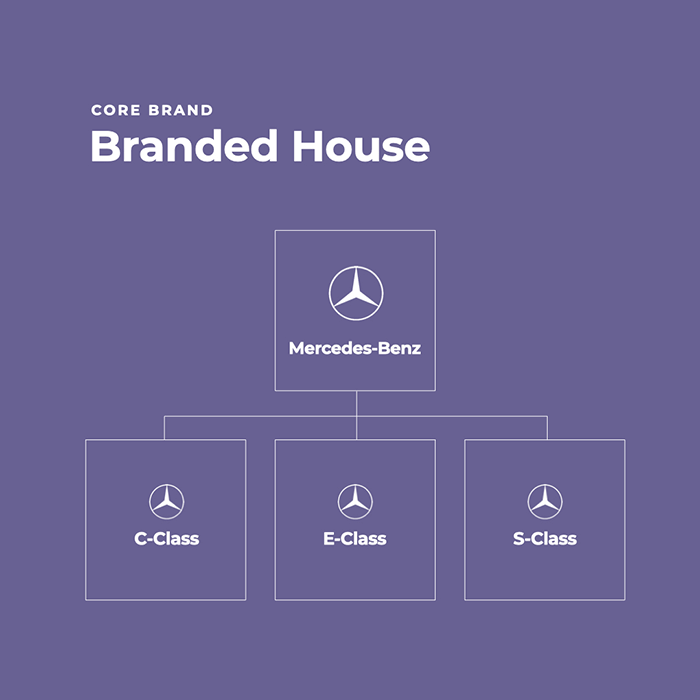Welcome to the second post in our series on brand architecture models. This article will explore the first of several foundational models: the branded house (or core brand).
Get answers to what a branded house is and how it can benefit a company, plus learn how to develop one. Future articles will delve into everything you need to know about other models, including:
Did you miss our introduction to this series? Check it out by visiting “Brand Architecture Models: An Introduction, Thoughts, and Perspectives.”
What is the branded house brand architecture model?
The branded house model is characterized by a single unified brand name known to consumers. That brand name will also encompass more than one category.
In the branded house model, products align with the single overarching brand position established by the core corporate brand name and typically won’t have their own distinctive identities per se.
In the diagram below, note the connected lines between the brand boxes, signifying a direct connection between the core brand and its sub-brands.

Think of a very close-knit family that does everything together—even dresses alike. So much so that the children intentionally mimic the parent, and their identities are inextricably tied to that parent brand.
Whatever position the core (or parent) brand takes in the marketplace, the children will follow. What the child brands lose in terms of product personality, positioning, or identity of their own, they will gain in the collective benefit of tight alignment with the parent brand and the consumer confidence that the core brand has established.
The branded house is a solid and sustainable brand architecture model time-tested by well-known brands like Target, FedEx, and Sony.
Branded house example
In the next diagram, you can see a classic example of a branded house model, Mercedes Benz. The Mercedes’ sub-brands, or children brands, are represented by names that are more indicative of a military designation than a brand personality.
The Mercedes’ sub-brand identities are intentionally tamped down in deference and homage to the parent brand name. All brand equity flows from the core name brand, Mercedes Benz, or, more commonly, Mercedes. The child brands are classified as, simply, A-Class, B-Class, C-Class, E-Class, S-Class, GLE-Class, and GLC-Class—luxury euphemisms (for the most part) for small, medium, and large, which is not unlike Starbucks’ tall, grande, and venti.

Why does the branded house model matter as a brand architecture model?
Beyond its seeming simplicity, this brand architecture model offers a layered strategy and cost-effective approach. But how does this manifest in real-world branding?
Highly-functional dysfunction
It may seem dysfunctional to intentionally create sub/child brands devoid of their own positioning, personality, or identity. Even if they don’t stand for much on their own, this is nevertheless an elegant and highly functional brand architecture model.
Being cost-effective and focusing is smart business
When using the core brand, marketing teams can concentrate their marketing channel and ad spend largely on the parent, in this case, Mercedes.
For instance, when Mercedes’ brand teams take an S-Class vehicle to market, the same general messaging, positioning, identity, look, feel, voice, vibe, tone, tenor, and timbre apply. This helps the launch deploy much more fluidly.
“Apple has competed with the likes of Louis Vuitton, Cartier or Prada which made us raise the question: Is Apple actually a luxury stock? Yes. Apple competes well across all of these different sectors because of its versatility in its functionality, but like luxury brands, it’s also competing as a way to express status and to fit in. Consumers are buying the spirit of the brand and the way it makes them feel about themselves and in society.”
Erwan Rambourg, HSBC analyst
CNBC
How to create a branded house
Developing a cohesive branded house brand architecture model requires strategic thinking and a focused approach. Here are some tips to help you get started.
Start with a strong central brand
At the heart of a branded house model is your core brand, which serves as the foundational pillar for all other sub-brands. Before you branch out and add sub-brands, solidify your core brand’s messaging, visuals, and values.
All of these extensions should naturally emanate from this primary identity, ensuring a cohesive look, feel, and voice. Conduct a thorough brand audit to ensure that you’ve defined your core brand well so that it resonates with your target audience.
Ensure consistency across touchpoints
One of the major benefits of a branded house model is consistency across sub-brands. This consistency aids in quick recognition and reinforces trust for the entire branded house.
To achieve this, create comprehensive brand guidelines. This should cover everything from logo usage, color palettes, typography, and even tone of voice for written content.
Every time you introduce a new product or service under a core brand, you should make sure it adheres to these guidelines. This will ensure that no matter where your customers interact with your brand, the experience feels seamless and familiar.
Prioritize strategic alignment over expansion
It can be tempting to keep adding new products or services under your branded house umbrella. This can be especially true when the central brand becomes well-established. However, it’s crucial to ensure that any new addition aligns with the overarching brand strategy and ethos.
Each new sub-brand should complement, not dilute, the main brand’s strength. Regularly revisit your brand’s core values and mission when considering expansion.
Sometimes a new offering doesn’t align or feels like a stretch. In these instances, it may be worth rethinking its inclusion under the branded house structure.
FAQs about the branded house
Here is a look at frequently asked questions about this brand architecture model to help further demystify its strategic advantages and applications.
What’s the difference between a branded house and source brand?
A branded house focuses on promoting the main brand while a source brand allows for more distinct sub-brand identities but still carries the endorsement of the primary brand.
Why would a company choose a branded house strategy?
Some of the reasons why you might opt for this model for your company include:
- You want cost efficiency in marketing
- You need a unified brand message
- You’re looking to build strong brand equity around one core brand
Does the branded house model save costs on marketing and branding?
Yes. By focusing on a core brand, you can streamline marketing efforts can save on marketing costs and reduce the complexity and expense of managing and promoting multiple distinct brands.
How can a branded house model impact brand equity and brand value?
A strong branded house can amplify brand equity as all products/services benefit from the reputation and trust of the main brand.
This concentrated brand equity can translate into higher brand value in the market, attracting loyal customers and potential investors, according to David A. Aaker, the “father of modern branding.”
Aaker has written extensively on brand equity and brand architecture. You can read more about this topic specifically in his book Managing Brand Equity: Capitalizing on the Value of a Brand Name (2009).
How does a branded house architecture influence customer perceptions?
Using a core brand can cultivate a cohesive and consistent brand experience, leading customers to associate all products or services under that umbrella with the same level of quality, trustworthiness, and value.
This can strengthen customer loyalty and enhance overall brand perception, as each product or service reinforces the core brand’s values and promises, according to Aaker (Building Strong Brands, 1996).
Brand equity and brand value
It stands to reason that honing the position of a single parent brand versus a dozen unique sub-brands is cost-effective. But it also allows for increased brand awareness around a single rallying point, like Mercedes. That means more focused exposure and more cost-effective marketing investment while enabling deeper market saturation.
That all equates to increased brand equity. And brand equity equates to brand value in a real and material way on the open market. Like Apple (which is a source brand, similar to a branded house), Mercedes’s value is its brand.
The branded house model’s power lies not just in its simplicity but also in its ability to consolidate—and amplify—brand value.
The branded house: Simplicity meets efficacy
Using a core brand stands the test of time because it inherently serves up a simpler, more digestible outward brand-facing to your select audiences.
If the parent brand finds product market fit and is nurtured properly in terms of consistent usage and proper positioning, all boats rise.
With this model, what’s not to like? Well, differentiation, for one. And we’ll see that clearly unfold as we unpack the house of brands framework in our next installment on brand architecture models.
